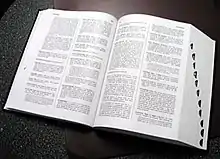
A dictionary with thumb indexes (on the right).
A thumb index, also called a cut-in index[1] or an index notch,[2] is a round cut-out in the pages of dictionaries, encyclopedias, Bibles and other large religious books, and various sectioned, often alphabetic, reference works, used to locate entries starting at a particular letter or section. The individual notches are called thumb cuts.
Several ways to achieve this indexing effect were invented and patented in the 1970s by Arthur S. Friedman, a printing engineer in New York.[3]
See also
References
- ↑ "thumb index". Bookbinding and the Conservation of Books: A Dictionary of Descriptive Terminology. Foundation of the American Institute for Conservation. Retrieved 8 May 2012.
- ↑ Popular Mechanics. Hearst Magazines. Sep 1956. p. 184.
- ↑ "Google Patents". patents.google.com.
This article is issued from Wikipedia. The text is licensed under Creative Commons - Attribution - Sharealike. Additional terms may apply for the media files.